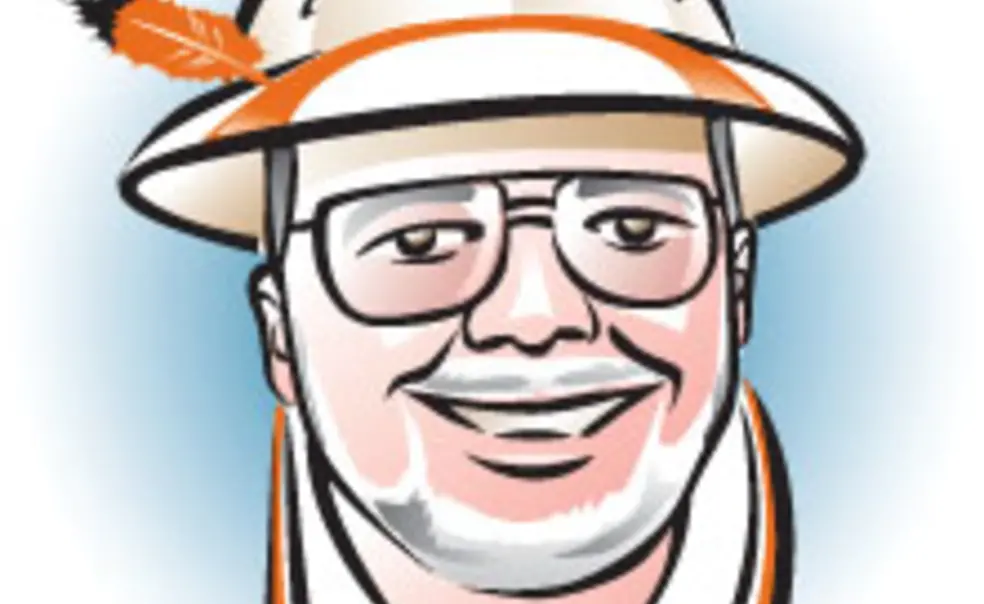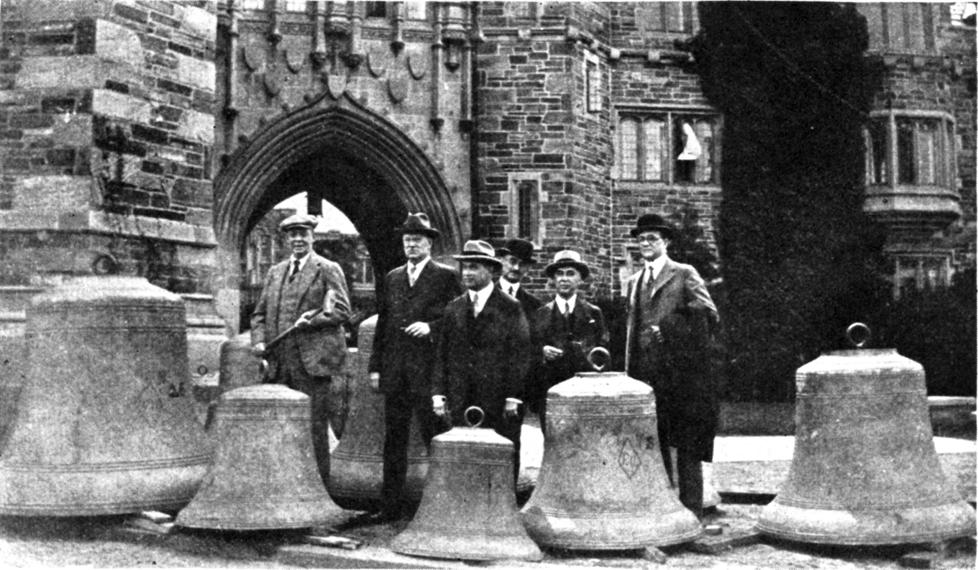I stopped by the Graduate College on a recent Sunday to enjoy one of the summer concerts at Cleveland Tower’s Class of 1892 Carillon. Edward Nassor from the National Cathedral in Washington, D.C., was playing, lucky for me, and the resulting renditions of Pachelbel’s Canon, Schubert’s “Heidenroslein” (my old German favorite from high school), and even such modern goodies as “Morning Has Broken” (the Cat Stevens version from the ’70s) and Erroll Garner’s plaintive “Misty” were salve for the soul. You just can’t be peeved at life when you’re listening to a well-played carillon.
So it’s probably fortuitous that absolutely the best place to hear the great bells is the seventh tee of the Springdale Golf Club, near the foot of the tower. Angelic intervention is certainly desirable when you’re playing from the blue tees ;maybe golf coach Will Green even has an incipient divinity student on the squad. But that’s not why the carillon is there; nor is the potential uplift of the graduate students in their adjacent Hogwarts-like Procter Hall, nor even the multitalents of the legendary Andrew Fleming West 1874, founder of both the Graduate School and the Glee Club (trivia alert!), who lived but a hundred yards away when the carillon debuted in 1927. This is really the story of somebody else, someone who heard more bells than Edgar Allen Poe.
Dr. Charles D. Hart 1892 of Philadelphia had been to the Low Countries of Europe and listened to some of the great mechanical carillons (not the cute chimes or celesty things then scattered around the United States) and some of the magical artists who made them sing and cry. He had carillons on the brain, and his brain was unrelenting.
In 1925 the country was flush, and the Class of 1892 was beginning to raise funds for a gift at its 35th reunion. The Princeton trustees wanted another new dorm: Henry and Foulke were a big hit with the students, 1901 Hall and Laughlin were about to break ground, and more would be great. They passed the word to ’92. When Hart heard about it, he thought instead about president John Grier Hibben 1882’s pet project, the grand new Chapel then under construction, and saw his opening. Feeling a dorm somewhat dull, he listened to the ringing in his noggin and went over his class officers’ heads, over the trustees’ heads, straight to God – uh, Rev. Dr. Hibben – and proposed a great carillon to add gravitas to the new church. A carillon is loud (the Princeton bourdon – bass bell – goes 13,000 pounds), but it’s not like the second-largest college chapel in the world was going to be a shrinking violet anyhow. Hart came prepared; he even had three alternative budgets from England in his pocket. Hibben was intrigued; the trustees capitulated.
What Hart didn’t have was a tower.
You really don’t want a 6 1/2-ton bell ringing in your ear; you want it waaaaaaaay up there where the entire countryside can hear it. There was no tower on the new Ralph Adams Cram Chapel. It cost well over $2 million without one. The class couldn’t afford a tower; they already were starting to be pressed by an “upgraded” bell proposal from Ward. Some quick calculations using the smallest proposed carillon showed that Holder Tower couldn’t hold one – hey, I told you they were big. Slooooooowly they turned to Cleveland Tower, the national monument to the former president that had marked the Graduate College from miles around since its dedication in 1913. That would do nicely. Ward, who dispensed hand-written correspondence and ideas about the carillon faster than aspirin, eventually pushed through a stunning 35-bell design costing a cool $60,000, which his class barely was able to raise in time. The bells were cast in Croyden (A.H. Rowan 1899, who happened to be at the foundry that day, tossed a “lucky” 1899 sixpence into the molten bronze) and then shipped over here.
On the Friday of Reunions, June 17, 1927, the first melody resounded over the golf course and across Lake Carnegie from the Class of 1892 Bells, all 31 tons of them. It was “The Orange and the Black.” There was very little written carillon music in the world then, but the opening three concerts combined a mélange of classical themes with “Old Nassau” and were a big hit. Then Dean West spoke up.
The instrument was in his College, on his own doorstep, and he wanted approval over its every use. The desperate sponsors, seeing their new baby begin to disappear, hammered out an agreement of brief melodies at dinnertime as the grad students daily went to Procter Hall, and one Sunday concert per week. The expensive automatic mechanism to play at other times on schedule essentially rotted away after early hiccups, and by 1940 the whole instrument was an unruly mess.
Then, in 1941, Arthur Bigelow came on the scene. Originally hired as a German professor, he became the first official carillonneur and immediately redesigned the array, secured funding, and expanded the instrument to 49 bells – more than four octaves – while moving the clavier (a sort of keyboard) up among the bells to improve the touch. Over the next 25 years he dropped all pretense of other interests, switched to engineering, and developed a new, scientific method of more precisely tuning bells. By 1967 when he died, he had re-redesigned the carillon, taken out 19 bells including all his own from the ’40s, added 37 more, and now had a colossal 67-bell instrument, one of the largest in the world. This still was paid for principally by the Class of 1892, even as the last of its number passed on.
Carillons are outdoors, by definition. Their rods and clappers and such get beaten up; the bells themselves age. Despite active use by carrillonneurs Bigelow and then Professor Walter Nollner, by 1993 the instrument was dangerously unstable, and again needed rehabilitation to the tune (no pun intended) of $400,000. A committee spearheaded by Van Zandt Williams ’65 and containing some great and generous Tigers – Bud Wynne ’39, William Sword ’46, and Charles Townsend ’49 – found it among such stalwarts as Bill Scheide ’36 and Laurance Rockefeller ’32, including a $100,000 donation by local arts maven Alex Ettl. The new low B-flat bell then cast for the carillon bears his name; one treble bell was removed, and the instrument – the fourth-largest in the United States and 11th in the world – was in fighting trim again. Robin Austin, the third carillonneur, who was deeply involved in the 1993 renovation, has run the challenging operation ever since, and now habitually draws the great bell players of the world to the 137 steps up to the cabin in the sky, where the clavier overlooks the golf course and where inspiration abounds. Dei sub numine viget.
When the old Nassau Hall bell (now on view in Frist Campus Center) cracked and gave up its 97-year-old ghost, a lovingly cast replacement (supervised by Arthur Bigelow) was waiting to be hoisted into its place. he new bell was the gift, commissioned just in case the old bell should ever fail, of Dr. Charles Hart 1892, who had died in 1951, four years before it would be needed. Even from beyond the grave, his truly was a class with a peal.













No responses yet